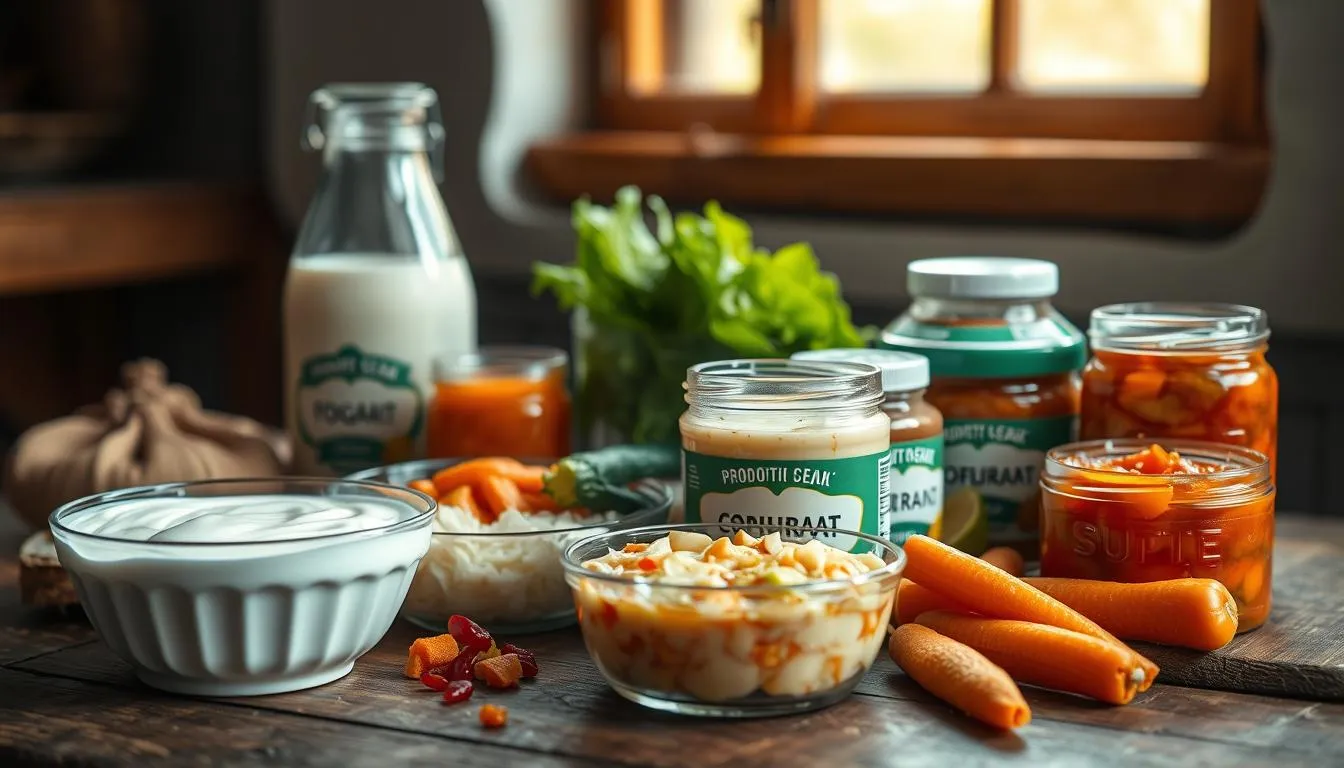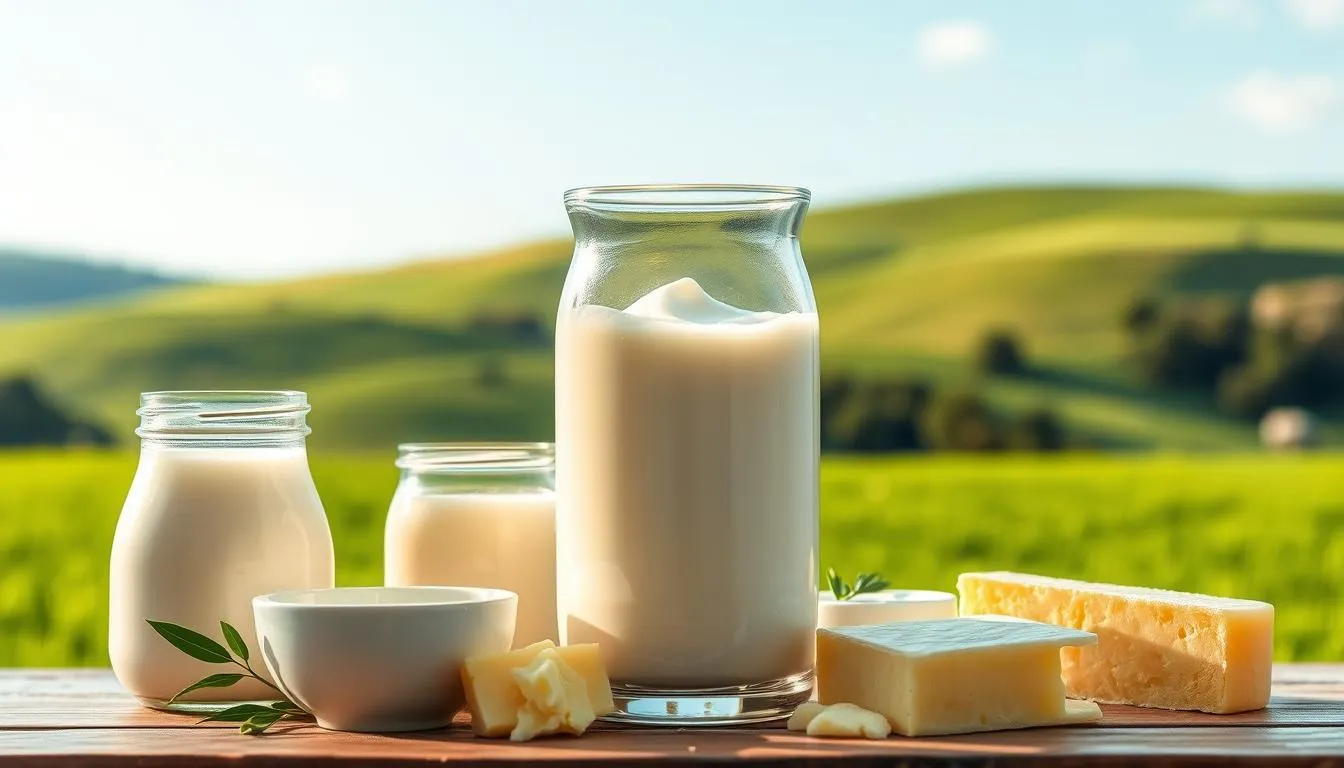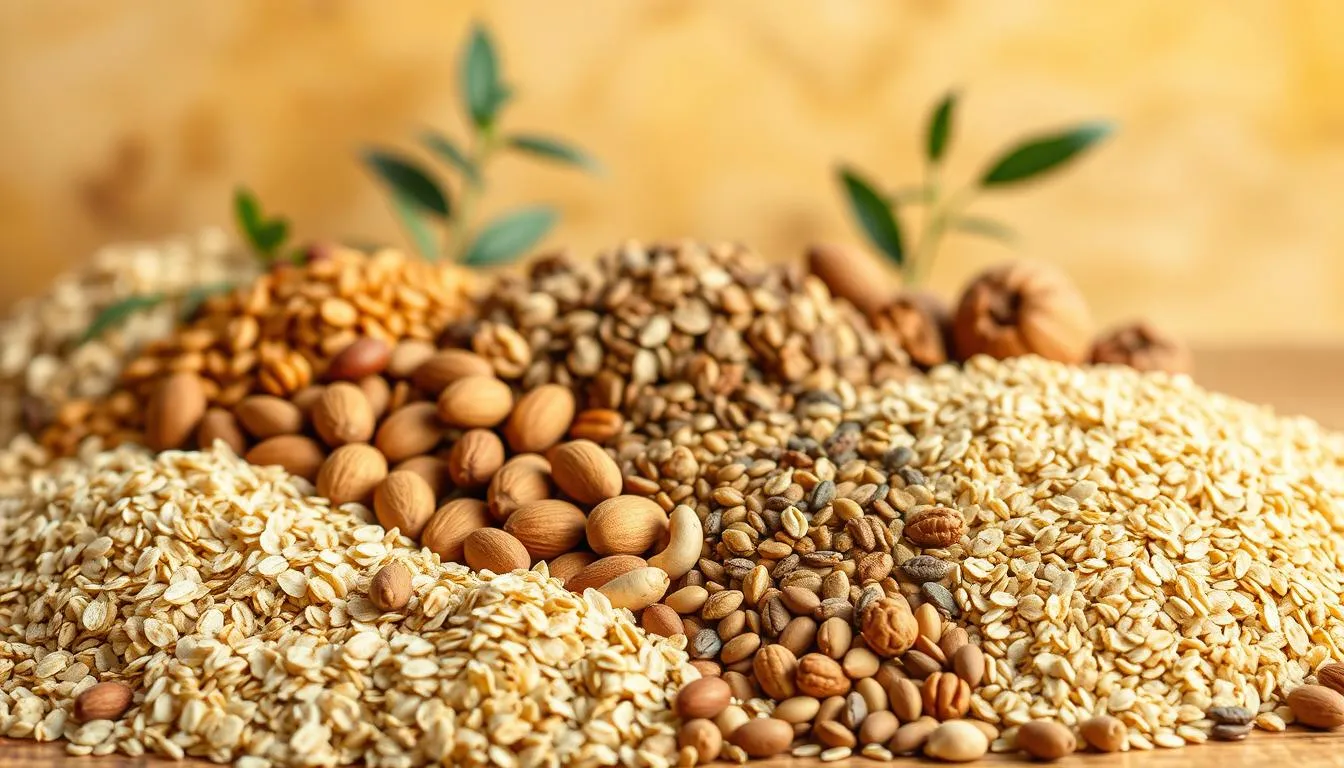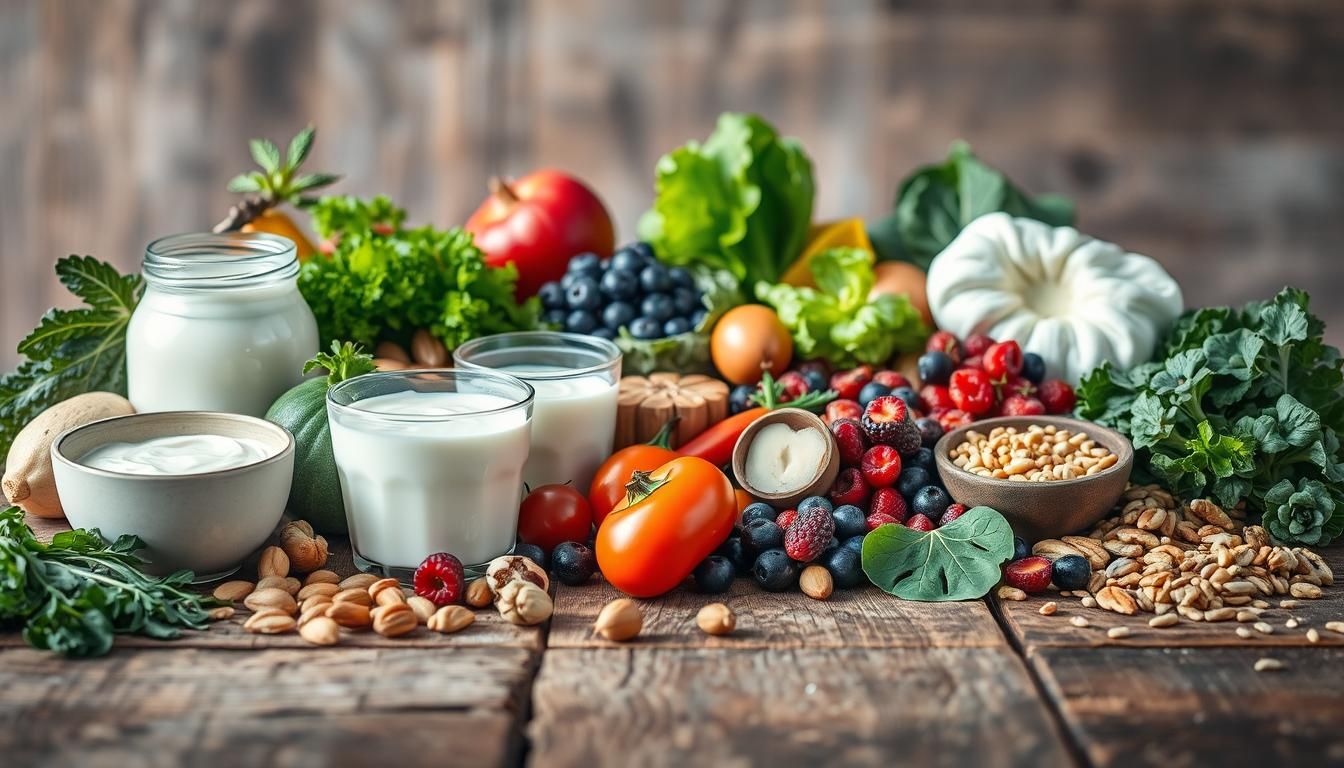Some days my stomach felt loud and a little out of sync — and that made everything else harder. I started small: one swap at breakfast, a yogurt at lunch, a handful of nuts as a snack. Within weeks, I noticed better energy and steadier moods.
These simple changes matter now. The market backing these choices surpassed $333B in 2023 and keeps growing, and new research links a diverse microbiome to digestion, immunity, and mood. Small moves can feed good bacteria and support gut balance without a big diet overhaul.
This article is a practical listicle. Expect clear information, portion tips, sugar awareness, and quick prep wins. We’ll cover fermented picks, dairy with live cultures, fiber-rich produce, whole grains and nuts, and friendly fats. Pick two easy wins today and build from there — consistent steps create lasting benefits.
Key Takeaways
- Small swaps, like one change per meal, can improve digestion and energy.
- Fiber is foundational; it ferments into compounds that nourish colon cells.
- Diverse microbiome links to immunity and mood, not just digestion.
- Market size and research show these choices are evidence-aligned, not fads.
- Look for portion guidance, low added sugar, and simple prep tips to stick with changes.
Why Gut Health Matters Right Now: What the Research Says
Research now links what happens in the belly to how we feel, think, and cope with stress. That idea helps explain everyday swings in mood, sleep, and focus. Digestive signals travel both ways between the gut and the brain, so balance in one supports the other.
What studies show: microbiome diversity relates to stronger immunity and lower long‑term disease risk. Imbalance, or dysbiosis, ties to anxiety, low mood, and inflammatory conditions.
Digestive problems — gas, constipation, and diarrhea — affect millions. About 15% of people in Western countries report IBS or bowel sensitivity. Targeted diet changes can ease these symptoms over time.
The practical takeaways
- Adding varied, fiber‑rich items and fermented choices supports bacterial growth and variety.
- Probiotics help some people, but consistent eating patterns drive bigger results.
- Dial down known triggers while you add supportive items — think “add before subtract.”
Next: we’ll turn this research into clear meal‑level picks you can use every day.
Functional foods for gut health
Everyday pantry picks can actively support a balanced microbiome and smoother digestion.

What makes a food go beyond calories: items that deliver live cultures, non‑digestible fiber, or metabolites that help the gut microbiome thrive. These elements support bacterial growth and overall health in ways that matter for digestion and energy.
Key building blocks include probiotics (live cultures), prebiotics (the fibers that feed them), and postbiotics (the metabolites those microbes produce). Synbiotics pair a probiotic with its preferred fiber so both survive and work better.
| Category | Main role | Easy picks |
|---|---|---|
| Fermented | Adds live probiotics | Yogurt, kimchi, kefir |
| High-fiber | Feeds microbes → SCFA production | Whole grains, nuts, bananas |
| Synbiotic combos | Helps survival & growth | Yogurt + oats, kefir + fruit |
Label tips: look for “live cultures” and 3+ grams of fiber per serving. Consistent intake, not one‑off trends, gives the biggest benefits — expect steadier energy and less discomfort over weeks.
Learn more on probiotics in clinical summaries like this probiotics research. For a comprehensive guide to specific prebiotic and probiotic foods, check out our detailed article on top prebiotic and probiotic foods for a healthy gut. Next sections will list the top fermented and dairy picks to add easily at meals.
Top Fermented Foods to Feed Good Bacteria
Adding everyday fermented items is a simple way to bring live cultures, vitamins, and bold taste to regular meals.
Kimchi: Spicy probiotics plus fiber and vitamins
Kimchi delivers probiotics, fiber, and vitamins in a spicy punch. Try a few tablespoons on grain bowls, eggs, or tacos to boost your gut and taste buds.
Sauerkraut: Choose raw, non‑vinegar‑pickled varieties
Pick refrigerated, raw sauerkraut to get active cultures and fiber. A small scoop alongside meats or salads adds tang and live cultures without fuss.
Kefir: Versatile probiotic drink for smoothies and dressings
Kefir is a fermented milk drink rich in live bacteria and protein. Blend a cup into smoothies or whisk with lemon and herbs for a tangy dressing that supports daily health.
Miso: Savory paste with beneficial enzymes
Miso brings savory umami and enzymes that may aid digestion. Population data link regular miso consumption with better gut outcomes, though bacterial survival varies. Use it cold or add at the end of cooking to protect its properties.
Kombucha: A probiotic beverage option beyond water
Kombucha is a fizzy, fermented tea with probiotics and a sharp, vinegary taste. Check sugar content and enjoy it with meals or mixed with fruit for a soda alternative.
- Rotate these items weekly to support a resilient microbiome and avoid flavor fatigue.
- Store refrigerated and avoid high heat after fermentation to protect live cultures.
- Pair fermented picks with whole grains or veggies to feed gut bacteria and sustain benefits.
- A few tablespoons of kimchi or sauerkraut, a cup of kefir, or a small kombucha bottle make easy daily targets.
Dairy That Delivers Probiotics (and When to Be Mindful)
Not all dairy delivers the same microbial benefits—labels matter. Live-culture yogurt can be an easy source of friendly bacteria when chosen carefully.

How to pick yogurt that helps: look for “live and active cultures” and minimal added sugar. Check the content list for culture names and fiber per serving when possible.
| Product | Benefit | Tip |
|---|---|---|
| Low-sugar yogurt | Steady probiotics, lower calories | Add fresh fruit & nuts to control sweetness |
| Yogurt drinks | Often higher bacteria counts | Watch sugar; choose small servings |
| Live runny cheeses (Roquefort) | May support microbes | Enjoy in moderation; avoid during pregnancy |
Build a parfait with plain yogurt, berries, and almonds to boost fiber and texture. Swap yogurt or kefir into dressings and dips for tang and probiotic benefits. For more protein-rich meal ideas that support gut health, explore our cottage cheese recipe collection.
Portion guide: about 3/4–1 cup per serving fits most needs. Consistent, modest servings most days matter more than occasional large amounts for better gut health.
Fiber-Rich Produce Powerhouses for a Healthy Gut
Vegetables rich in fiber and unique sugars are simple allies for a balanced microbiome. Leafy greens, bananas, peas, and a few aromatic roots each bring different nutrients and feeding patterns for helpful microbes.
Leafy greens
Leafy greens supply fiber plus folate, vitamins C, K, and A. They also contain specific sugars that fuel growth of beneficial gut bacteria.
Eat a handful daily—salads, smoothies, or wilted with grains make it easy.
Bananas
Bananas are a low‑fructose snack with inulin, a prebiotic fiber that supports steady digestion. Try one with nut butter or sliced on oats.
Peas and Brussels sprouts
Peas offer both soluble and insoluble fiber to keep things moving comfortably.
Brussels sprouts add fiber and sulfur compounds that may help limit undesirable bacteria like H. pylori.
Garlic and ginger
Garlic has antibacterial and antifungal properties while still fueling helpful microbes when used in food.
Ginger can stimulate stomach acid and motility; grate it into soups or tea for quick relief.
“Small changes to produce intake can yield steady results.”
- Use bagged greens, frozen peas, and pre-peeled garlic to save time.
- Increase fiber slowly and drink more fluids to reduce gas as your body adapts.
- Think produce as the primary source of the fiber and phytonutrients your gut thrives on.
Whole Grains, Nuts, and Seeds: Prebiotic Fuel for SCFA Production
Choosing whole oats or brown rice over white options helps produce the short‑chain acids your colon needs.

Why choose whole grains? Whole grains add fiber and omega‑3 precursors that refined carbohydrates lack. Aim to build toward ~25 g of fiber daily by adding 1/2–1 cup cooked whole grains per meal.
Fermentable fibers in oats, barley, and brown rice break down into short‑chain fatty acids (SCFAs). SCFAs nourish colon cells and support bowel integrity.
About 70% of immune cells live near the large intestine, so these metabolites help local immune function and bacterial balance.
Almonds: a simple, power-packed snack
Almonds supply fiber, fatty acids, and polyphenols. A small handful offers prebiotic benefit and probiotic‑like support that encourages beneficial bacteria growth.
“A handful of nuts can bridge the gap between meals and feed helpful microbes.”
| Item | Typical serving | Key benefit |
|---|---|---|
| Oats (cooked) | 1/2–1 cup | Fermentable fiber → SCFA production |
| Brown rice | 1/2–1 cup | Slow carbohydrates, steady fuel for microbes |
| Almonds | 1 oz (about 23) | Fiber, healthy fatty acids, polyphenols |
- Swap white pasta or bread for whole‑grain versions to boost daily fiber.
- Pair grains with legumes and vegetables to diversify the fibers your microbiome uses.
- Read labels: make sure “whole” grains are the first ingredient and fiber per serving is high.
Practical takeaway: steady, daily fiber from whole grains, nuts, and seeds helps bowel comfort and regularity. Quality choices matter more than strict omission of grains.
Fats and Oils That Calm the Gut
Gentle oils and creamy plant fats can help reduce inflammation and soothe the belly.
Olive oil delivers polyphenols and fatty acids that lower gut inflammation and may ease indigestion. It can also reduce how hard the pancreas must work after a meal, making digestion gentler than heavy cooking fats.
Olive oil: polyphenols and fatty acids
Choose extra‑virgin olive oil for dressings or a light drizzle over grains and greens to get its properties and benefits. Use it in simple marinades, light sautéing, or finishing dishes to protect nutrients.
Avocado: creamy fiber and potassium
Avocado adds fiber, potassium, and a creamy texture with low fructose. Be mindful of portion size since it is calorie‑dense.
- Portion cue: aim for about 1–2 tablespoons of oil per meal and roughly 1/3–1/2 avocado as a serving.
- Pair fats with fiber‑rich produce and whole grains to boost satisfaction and steady digestion.
- Simple upgrades: olive oil with lemon, herbs, or a pinch of chili over salads or bowls.
- Check labels and favor minimally processed oils to protect beneficial nutrients and properties.
Consistency beats trends: regular use of quality fats supports gut and overall health more than occasional “superfood” splurges. For a deeper look at healthy fat choices, see this guide to eating healthy fats.
Smart Listicle: Build Your Gut-Friendly Plate in the U.S.
Think of each meal as a chance to add live cultures, fiber, and healthy fats with easy swaps. Aim for colorful, varied plates across three meals to steady energy and digestion.
Breakfast ideas
Blend kefir with berries and oats or make a live-yogurt parfait with low-sugar fruit. Add whole-grain toast with olive oil or avocado for steady energy.
Lunch and dinner
Assemble kimchi grain bowls with greens, beans, and a miso-tahini drizzle. Pair proteins with a sauerkraut side and a large leafy salad to add probiotics and fiber.
Snacks and sips
Choose a handful of almonds, a small kombucha, or fruit with yogurt to keep habits effortless. Watch sugar in flavored yogurts and some beverages.
Portions and regularity
Three balanced meals daily help your system find a comfortable rhythm. Use simple portion cues to match energy needs and increase fiber slowly.
“Pick one win per meal and build from there — consistent steps create a good gut over time.”
- Most U.S. grocers now carry kefir, kimchi, and raw sauerkraut, so access is easy.
- If you’re new to ferments or higher fiber, go gradual and hydrate to avoid discomfort.
- Think of this as a practical way to support gut health without an overhaul.
Trends, Labels, and Safety: Navigating the Functional Food Aisle
New product claims mix science, marketing, and regional rules — so decode them carefully.
What claims mean: Probiotics, prebiotics, and “gut‑friendly”
Labels can signal real benefit or just marketing language. In the U.S., FDA rules require evidence for health, nutrient, and structure/function claims. In the EU, the word “probiotic” may be treated as a health claim and is tightly controlled.
Check strain names, culture counts at end of shelf life, and storage directions. Also compare fiber grams and added sugar to get clear information on product value.
Market momentum and product access
The global digestive products market hit $51.62B in 2023 and keeps growing (CAGR 8.3% to 2030). This fuels innovations: next‑gen probiotics, advanced prebiotics, synbiotics, and postbiotics that aim to support the microbiome and the brain‑gut system.
Who should be cautious
Start slow if you have IBS or other digestive issues. Rich, fatty items and sudden jumps in ferments or fiber can trigger symptoms. Gradual changes help your system adapt and lower risk of discomfort.
“Compare products using objective measures—fiber, sugar, strain info—and favor clear sourcing.”
- Favor clean‑label items with short ingredient lists and transparent sourcing.
- Expect regulatory differences that affect what you see on U.S. shelves versus other regions.
- Build steady patterns across the week; consistent choices beat single product fixes.
Conclusion
A steady pattern of ferments, fiber, whole grains, and good fats builds resilience over time.
Big idea: a simple plate that blends fermented items, leafy produce, whole grains, olive oil, and mindful dairy can support gut health you notice in daily life.
Go slow. Sudden swaps can change bowel habits and cause stomach upset. Choose lean meat and whole grains over rich, fatty options and refined carbohydrates.
Anchor each day with one ferment, one green, one whole‑grain choice, and olive oil. Keep almonds or other nuts handy as a quick, satisfying snack.
Millions manage sensitivities; pace changes and tune portions. Pick two habits to start this week (for example, kefir at breakfast and greens at lunch) and build from there. Small, consistent choices compound into clear benefits for your microbiome and digestion.
FAQ
What are the best probiotic sources to add to my daily meals?
Fermented items like kimchi, sauerkraut (raw, non-vinegar), kefir, miso, and kombucha supply live bacteria that can support a balanced microbiome. Choose low-sugar yogurt with live cultures and plain kefir if you want higher colony counts. Start with small portions to assess tolerance and pair them with fiber-rich foods to feed those microbes.
How do prebiotics differ from probiotics and where do I get them?
Probiotics are live microbes; prebiotics are non-digestible fibers that fuel beneficial bacteria. Good sources include whole grains, bananas, garlic, onions, leafy greens, peas, Brussels sprouts, nuts like almonds, and seeds. Regular intake helps boost short-chain fatty acids (SCFAs) that support colon health and immune function.
Can changing my diet really affect mood or brain function?
Yes. Research on the gut-brain axis shows that gut microbes influence neurotransmitter production and inflammation, which can affect mood, stress response, and cognition. Eating diverse plant foods, fermented items, and healthy fats like olive oil and avocado supports microbial balance linked to better mental well-being.
How much fiber should I aim for to support beneficial bacteria?
Aim to meet general dietary fiber guidelines (about 25–30 grams per day for many adults) from a mix of soluble and insoluble sources: whole grains, fruits, vegetables, legumes, nuts, and seeds. Increase fiber gradually and drink plenty of water to reduce bloating or bowel discomfort.
Are fermented products safe for everyone?
Most people tolerate fermented items well, but those with small intestinal bacterial overgrowth (SIBO), severe IBS, certain immune conditions, or on specific medications should consult a clinician before large servings. Also watch sodium in some products and added sugars in kombucha or yogurt drinks.
What role do fats and oils play in a balanced microbiome?
Healthy fats like extra-virgin olive oil and avocado provide polyphenols and monounsaturated fatty acids that reduce gut inflammation and support microbial diversity. Limit excessive saturated and trans fats, and keep portion sizes moderate to avoid digestive upset.
Can I get probiotic benefits from cheese and other dairy?
Certain live-culture cheeses (like some blue cheeses and cultured varieties) and yogurts deliver probiotics. Choose low-sugar products and enjoy them in moderation, especially if you are lactose intolerant or sensitive to dairy.
How quickly will I notice benefits after improving my diet?
Some people notice changes in digestion or energy within days to weeks, but durable shifts in microbiome composition and related health benefits may take several weeks to months of consistent eating patterns. Regular meals, fiber variety, and fermented foods help sustain gains.
Are there labels or claims I should trust when shopping for microbiome-focused items?
Look for transparent labels listing specific probiotic strains and CFU counts, “live cultures” wording, and minimal added sugars. Terms like “prebiotic” indicate fiber content but vary in meaning. Verified third-party testing and reputable brands such as Stonyfield, Siggi’s, or GT’s can offer extra confidence.
How can I build a gut-friendly plate in the U.S. while keeping portions sensible?
Aim for three balanced meals: a fermented element (kefir, yogurt, or kimchi), fiber-rich produce (leafy greens, bananas, peas), whole grains or legumes, a small serving of nuts or seeds, and a healthy fat like olive oil or avocado. Keep portion sizes aligned with your energy needs and spread fermented foods through the week.
When should I see a doctor about digestive issues despite dietary changes?
Seek medical advice if you have severe or persistent symptoms such as unexplained weight loss, blood in stool, chronic abdominal pain, high fever, or ongoing diarrhea that doesn’t improve with diet changes. A clinician can evaluate for IBS, inflammatory bowel disease, infections, or other conditions and advise tailored strategies.
